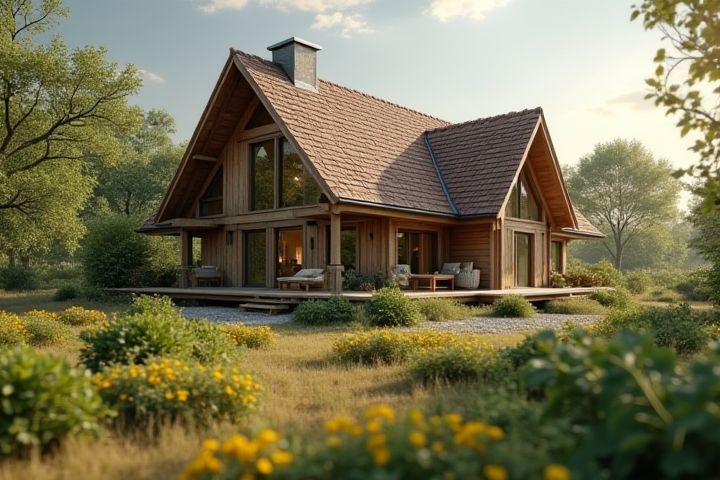
Incorporating energy-efficient appliances is essential for a sustainable house, as they significantly reduce electricity consumption. Installing solar panels not only harnesses renewable energy but can also lead to substantial savings on utility bills. Using sustainable materials, such as bamboo flooring or recycled insulation, minimizes environmental impact during both construction and renovation. Implementing rainwater harvesting systems can help conserve water resources and reduce dependency on municipal supplies. To enhance indoor air quality, consider using low-VOC paints and natural ventilation strategies to promote a healthier living environment.
How To Make A House Sustainable
Renewable energy sources
Utilizing solar panels can significantly reduce your household's reliance on traditional energy sources, with systems capable of generating 70%-100% of your energy needs, depending on your location. Wind turbines are another renewable option, boasting an efficiency of up to 50% in converting wind energy into electricity, making them ideal for rural areas. Geothermal heating and cooling systems utilize the Earth's stable underground temperature, achieving energy savings of 30%-60% compared to conventional systems. Considering these options can enhance your home's sustainability while lowering your energy bills and carbon footprint.
Insulation efficiency
Improving insulation efficiency is critical for creating a sustainable house, as it significantly reduces energy consumption and maintains comfortable indoor temperatures. Using high-quality materials such as cellulose, spray foam, or fiberglass can enhance your home's thermal envelope, minimizing heat loss during winter and reducing heat gain in the summer. Consider incorporating advanced insulation techniques like continuous exterior insulation and air sealing to limit drafts and energy leakage. Properly installed insulation not only contributes to a lower carbon footprint but also leads to reduced utility bills and a more sustainable living environment for you and your family.
Water conservation systems
Incorporating water conservation systems is essential for making your house sustainable. Rainwater harvesting systems can capture and store rainwater for irrigation or non-potable uses, significantly reducing your reliance on municipal water supplies. Additionally, installing low-flow fixtures and appliances such as faucets, showerheads, and toilets can minimize water usage without sacrificing performance. Implementing greywater recycling systems allows you to reuse water from sinks and showers for landscaping, further enhancing your home's sustainability and reducing environmental impact.
Sustainable building materials
Sustainable building materials are essential for creating an eco-friendly home, significantly reducing environmental impact. Recycled steel, bamboo, and rammed earth are prime examples that prioritize durability and minimize resource depletion. For insulation, consider using cellulose made from recycled paper, which boasts an impressive R-value, enhancing energy efficiency. By choosing sustainable materials, you not only lower your carbon footprint but also ensure your home remains resilient and energy-efficient for years to come.
Energy-efficient appliances
Investing in energy-efficient appliances is a crucial step toward making your house sustainable. Look for appliances marked with the ENERGY STAR label, indicating they meet strict efficiency guidelines and help reduce your energy consumption significantly. By replacing older models with newer, energy-efficient versions, you not only lower your utility bills but also decrease your carbon footprint. Consider appliances like smart thermostats, LED lighting, and high-efficiency washing machines, which can seamlessly integrate into your home while promoting an eco-friendly lifestyle.
Passive solar design
Passive solar design leverages strategic architectural elements to enhance energy efficiency, reducing your reliance on mechanical heating and cooling. By orienting your home towards the sun, you can maximize natural light and heat gain during winter, which may decrease energy bills by 30-40%. Utilizing materials with high thermal mass, such as concrete or brick, helps absorb and store solar energy, maintaining stable indoor temperatures throughout the year. Incorporating roof overhangs and strategically placed windows also minimizes overheating in the summer, ensuring your living space remains comfortable while contributing to overall sustainability.
Smart home technology
Implementing smart home technology significantly enhances a home's sustainability by optimizing energy usage. Smart thermostats, like the Nest Learning Thermostat, can reduce heating and cooling costs by up to 15% by learning your schedule and adjusting temperatures accordingly. Energy-efficient smart lighting systems, such as Philips Hue, allow you to set timers and control usage remotely, saving approximately 20% on electricity bills. Additionally, integrating solar panels with smart energy management systems enables homeowners to monitor production and consumption in real time, promoting renewable energy use while decreasing reliance on fossil fuels.
Waste reduction strategies
Implementing waste reduction strategies in your sustainable home can significantly minimize your ecological footprint. Start by integrating composting systems to turn organic waste into nutrient-rich soil, reducing landfill contributions. Opt for purchasing products with minimal or recyclable packaging, and consider bulk buying to further decrease waste. Finally, assess your household's consumption habits, encouraging the use of reusable items such as cloth bags, glass containers, and refillable water bottles to promote sustainability.
Native landscaping
Native landscaping can significantly enhance your home's sustainability by promoting biodiversity and requiring less water than non-native plants. By incorporating native plants, you can reduce reliance on chemical fertilizers and pesticides, as these species are well-adapted to local soil and climate conditions. For instance, replacing traditional lawns with a native wildflower garden can save up to 50% more water during dry seasons, while attracting pollinators like bees and butterflies. To further enhance sustainability, consider using native shrubs and trees, which can provide shade, reduce energy costs, and create habitats for local wildlife.
LED lighting solutions
Incorporating LED lighting solutions can significantly enhance the sustainability of your home, as LEDs consume up to 75% less energy compared to traditional incandescent bulbs. Switching to LED lighting not only lowers your energy bills but also contributes to reducing greenhouse gas emissions, given that electricity generation is a major source of carbon output. Additionally, with a lifespan of up to 25,000 hours, LEDs require less frequent replacements, minimizing waste and the environmental impact associated with manufacturing and disposing of light bulbs. By strategically placing LED fixtures and using smart home technology to optimize lighting, you can create an energy-efficient, eco-friendly living space that aligns with sustainable principles.
